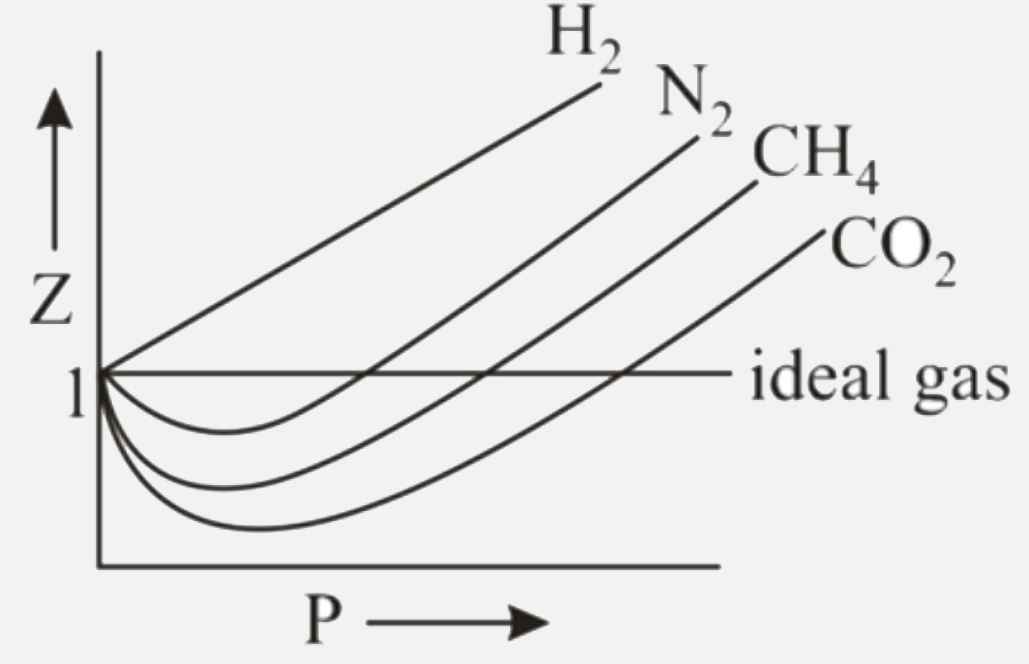For real gases, PVnRT........
To solve the question regarding the ratio PVnRT for real gases, we can follow these steps:
Step 1: Understand the Ideal Gas Law
The ideal gas law is given by the equation:
PV=nRT
where:
- P = pressure of the gas
- V = volume of the gas
- n = number of moles of the gas
- R = universal gas constant
- T = temperature of the gas in Kelvin
Step 2: Define the Compressibility Factor
For real gases, the behavior deviates from the ideal gas law, especially under high pressure and low temperature. The compressibility factor Z is defined as:
Z=PVnRT
This factor helps us understand how much the real gas deviates from ideal behavior.
Step 3: Analyze the Compressibility Factor at Different Conditions
1. At Low Pressure:
- For real gases at low pressures, the intermolecular forces are negligible, and Z<1. This indicates that the gas behaves more like an ideal gas.
2. At Moderate Pressure:
- As the pressure increases to moderate levels, Z approaches 1, indicating that the gas behaves closer to ideal behavior.
3. At High Pressure:
- At very high pressures, Z>1. This indicates that the gas molecules are closer together, and repulsive forces become significant, causing the gas to deviate from ideal behavior.
Conclusion
The ratio PVnRT for real gases varies depending on the pressure conditions:
- Z<1 at low pressures
- Z≈1 at moderate pressures
- Z>1 at high pressures
The ideal gas law is given by the equation:
PV=nRT
where:
- P = pressure of the gas
- V = volume of the gas
- n = number of moles of the gas
- R = universal gas constant
- T = temperature of the gas in Kelvin
For real gases, the behavior deviates from the ideal gas law, especially under high pressure and low temperature. The compressibility factor Z is defined as:
Z=PVnRT
This factor helps us understand how much the real gas deviates from ideal behavior.
1. At Low Pressure:
- For real gases at low pressures, the intermolecular forces are negligible, and Z<1. This indicates that the gas behaves more like an ideal gas.
2. At Moderate Pressure:
- As the pressure increases to moderate levels, Z approaches 1, indicating that the gas behaves closer to ideal behavior.
3. At High Pressure:
- At very high pressures, Z>1. This indicates that the gas molecules are closer together, and repulsive forces become significant, causing the gas to deviate from ideal behavior.
The ratio PVnRT for real gases varies depending on the pressure conditions:
- Z<1 at low pressures
- Z≈1 at moderate pressures
- Z>1 at high pressures
Topper's Solved these Questions
- STATES OF MATTERBOOK - CENGAGE CHEMISTRY ENGLISHCHAPTER - STATES OF MATTEREXERCISE - Exercises (Ture False)
25 Videos
- STATES OF MATTERBOOK - CENGAGE CHEMISTRY ENGLISHCHAPTER - STATES OF MATTEREXERCISE - Ex 5.4
32 Videos
- SOME BASIC CONCEPTS AND MOLE CONCEPTBOOK - CENGAGE CHEMISTRY ENGLISHCHAPTER - SOME BASIC CONCEPTS AND MOLE CONCEPTEXERCISE - Archives Subjective
11 Videos
- STOICHIOMETRYBOOK - CENGAGE CHEMISTRY ENGLISHCHAPTER - STOICHIOMETRYEXERCISE - Archives Subjective
33 Videos
Similar Questions
One way of writing the equation of state for real gases is
PV=RT[1+BV+….]
where B is a constant. Derive an approximate expression for B in terms of the van der Waals constants a and b.
View SolutionCompressibility factor, Z of a gas is given as Z=pVnRT
(i) What is the value of Z for an ideal gas ?
(ii) For real gas what will be the effect on value of Z above boyle's temperature ?
View Solution
Knowledge Check
Consider the equation Z=PVnRT, which of the following statements is correct?
AWhen Z > 1, real gases are easier to compress than the ideal gas.BWhen Z = 1, real gases get compressed easilyCWhen Z > 1, real gases are difficult to compress.DWhen Z = 1, real gases are difficult to compress
Real gases behave ideal at ........and .......
View SolutionOne way of writing the equation of state for real gases is PV=RT[1+RV+…] ? Where B is constant. Derive an approximate expression for B in terms of the van der Waals constant a and b.
View SolutionIf the ratio of PVm&RT for a real gas is x24 at a temp where (∂P∂Vm)=0. The find value of 10x.
View SolutionThe equation of state is PV = ..........
View SolutionFor gases behaving as per PV= nRT

View SolutionCompressibility factor (Z=PVnRT) is plotted against pressure

Which is the correct order of liquefiability of the gases shown in the above graph ?
View SolutionCompressibility factor Z=PVRT. Considering ideal gas, real gas, and gases at critical state, answer the following questions:
The cpmpressibility factor of an ideal gas is
View Solution
